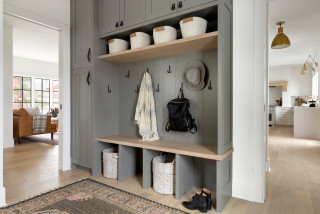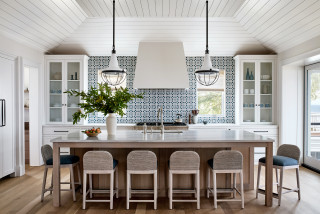
This article was originally published by a www.houzz.com . Read the Original article here. .

When you work with a pro who uses Houzz Pro tools, they can give you access to a Client Dashboard to monitor, track and advance your home remodeling or design project or new build. This is a private portal that includes your communication history, project details, timeline, financial documents, project progress photos and more, and it can be accessed via desktop or mobile.
Using the Client Dashboard can help build a positive working relationship with your professional — increasing transparency, reducing stress and fostering trust.
Here are six things the Client Dashboard offers to improve your project experience.
1. Improved Communication
The Houzz Pro Client Dashboard gives you easy access to your communication history and project details in one central place, where you can access it at a glance. Your pro can make communications, schedules, daily logs and more available to you so you’ll never lose track of requests, conversations or approvals.
Can’t remember the details of a conversation you had with your pro? The Client Dashboard acts as a reference point where you can access information instantly, rather than having to go through endless emails or texts. It can be viewed 24/7, giving you round-the-clock access for peace of mind, reducing the need for back-and-forth messaging with your pro.
Find home professionals on Houzz
This article was originally published by a www.houzz.com . Read the Original article here. .

For the most successful remodel, you’ll want to consider how you live now and how you’d like to live ideally. After all, remodeling is a chance to set new, more organized habits. Why not create a home that will make implementing your new habits easier? Here are four questions I recommend that you consider before you remodel.
This article was originally published by a www.houzz.com . Read the Original article here. .

Because holiday schedules can be all over the map, trying to coordinate a project installation at this time of year can be a challenge. In fact, it can be such a challenge than many pros suggest avoiding installations altogether and waiting until the new year to schedule them.
“A lot of our installers and subcontractors are also taking off for the holidays,” says Rebecca Sutton of Kitchen Design Concepts in Dallas. “We have conversations with our clients during the sales process — if their project timeline runs over the holidays, we know to begin their project at the start of the new year.”
Ruchi Agrawal Mohan of DesignbyRuchi in New York agrees that project installations during the holidays are a hassle. “It’s always harder to schedule deliveries and installations during the holidays,” she says. “The buildings are shut down for deliveries, clients are hosting and vendors are not available. I try to put installations on the schedule way ahead of time or after the holidays have passed.”
Stephanie Frees of Plain & Posh in Clarendon Hills, Illinois, also tries to avoid holiday installations. “I have always tried to get projects completed by Thanksgiving,” she says. “No one wants workers in their homes when they are trying to decorate for the holidays and then hosting holiday events.”
How to Create an Engaging End-of-Year Newsletter
This article was originally published by a www.houzz.com . Read the Original article here. .

Here, designers and contractors share their best advice for processing change orders and implementing major last-minute requests from customers. Take a look at these eight tips, then in the Comments tell us how you negotiate change orders with clients and team members.
This article was originally published by a www.houzz.com . Read the Original article here. .

Here, seven designers and contractors share their best advice for processing change orders and implementing major last-minute requests from customers. Take a look at these eight tips, then in the Comments tell us how you negotiate change orders with clients and team members.
This article was originally published by a www.houzz.com . Read the Original article here. .
Pantries are the best way to store canned goods, jars and bottles, as they keep everything in one organized space, says Simon Lennox of Adornas Kitchens & Interiors.
Of course, not all of us have the luxury of being able to incorporate a huge pantry, but even a small one can be a real bonus. “A well-organized larder cupboard will add a lot of storage space to a kitchen without necessarily taking up [too much] space, as they can be made to any shape and size,” Odile Kipling of SoKipling says
Kipling has some advice on how to get the most out of your pantry. “Do an inventory of what you want to store … and measure the tallest, widest, smallest and heaviest items to make sure everything has a place and is easily accessible,” she says.
“Pullout shelves or shallow drawers are ideal at the lower levels, especially if the cupboard is deep, so you don’t have to kneel down and reach for the items at the back,” Kipling says.
She suggests that pantry pullouts above the countertop are less practical because you may not be able to see inside them. Here she recommends shallower shelves and a rack on the back of the door for condiments, spices or — if you have enough cupboard depth — larger items such as pasta boxes.